Source: China Economic Net
China’s new energy vehicles have entered a new stage of large-scale, global and high-quality development, and the system strength is constantly maturing and the market position is continuously consolidated; More importantly, a number of highly competitive automobile brands in China have emerged. However, opportunities often coexist with challenges, and China’s new energy vehicles still have shortcomings in some key areas, which need to be overcome.
After 70 years of development, China automobile industry has entered a new stage of high-quality development. Since the beginning of this year, driven by the policy and market, China’s automobile production and sales have steadily increased, constantly hitting record highs, which has played an important role in promoting consumption and boosting economic development. Among them, new energy, automobile export and high-end car market have all become important forces to promote the development of the automobile market. To this end, China Economic Net auto channel will review and summarize these three aspects in order to help the industry further achieve high-quality development. Today, "New Energy Vehicles Leading the Way, High-quality Development Towards Automobile Power" was launched.
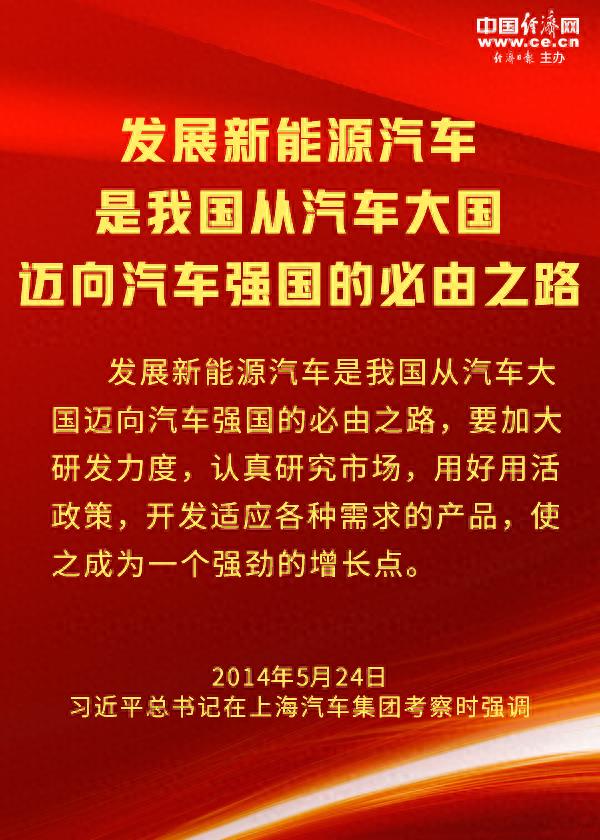
Developing new energy vehicles is the only way for China to move from a big automobile country to a strong automobile country. In recent years, driven by policy and market, China’s new energy automobile industry has achieved leap-forward development, and its production and sales have ranked first in the world for eight consecutive years.
According to the data of China Association of Automobile Manufacturers (hereinafter referred to as China Automobile Association), from January to October this year, the production and sales of new energy vehicles in China were 7.352 million and 7.28 million respectively, up by 33.9% and 37.8% respectively, and the market share reached 30.4%. In October, the production and sales were close to one million vehicles. In July this year, the 20 millionth new energy vehicle rolled off the assembly line, which marked that China’s new energy vehicle industry entered a new stage of large-scale and global high-quality development.
The China Automobile Association predicts that the production and sales of new energy vehicles will reach 9 million this year. At present, the cumulative sales volume of new energy vehicles in the first 10 months has exceeded that of last year. The China Automobile Association said that according to the current data, the production and sales targets of new energy vehicles can basically be achieved this year.
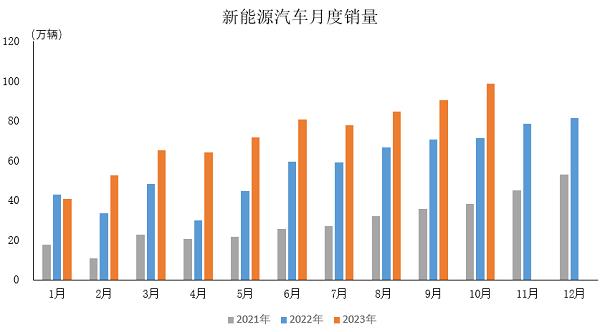
Source: WeChat public platform of China Automobile Industry Association
Policy escort, high-quality development of new energy vehicles
The scale of new energy vehicles in China continues to rise, which is inseparable from the "escort" of policies. Fang Haifeng, chief expert of China Automotive Technology and Research Center Co., Ltd. and deputy director of China Automotive Strategy and Policy Research Center, said, "From a policy perspective, the relevant state authorities have increased policy support during the market introduction period to promote the industrialization of new energy vehicles, adhered to diversified development, and introduced a series of policy measures, creating a good policy environment for the development of the whole industry and building a policy support system."
Since the beginning of this year, the national ministries and commissions have intensively introduced policies related to new energy vehicles, from the continuation of the vehicle purchase tax reduction policy for new energy vehicles to the end of 2027, to the launch of the "thousand counties and thousands of towns" new energy vehicle consumption season, to the promotion of the construction of charging infrastructure system, and to strengthen the safety management of new energy vehicles, improve the motor vehicle scrapping and renewal policy and the promotion mechanism of new energy vehicles, covering the whole life cycle of new energy vehicles from production, purchase, use to recycling.
This also makes the strength of China’s new energy automobile industry system mature, and its core position in the global new energy automobile industry becomes more and more stable. From the perspective of industrial layout, with the "Three Electricity" (battery, motor and electronic control) becoming the core components of new energy auto time, China has formed a competitive advantage in relevant industrial chains, and outstanding suppliers such as Contemporary Amperex Technology Co., Limited, Horizon and Hesai Technology have emerged. Zhang Yongwei, vice chairman and secretary general of China Electric Vehicle committee of 100, also said, "At present, China has formed a relatively complete electrification supply chain, which occupies an important position in the world. At this stage, about 70% of the global battery production capacity is in China. In the future, China is likely to become a global automotive supply chain center. "
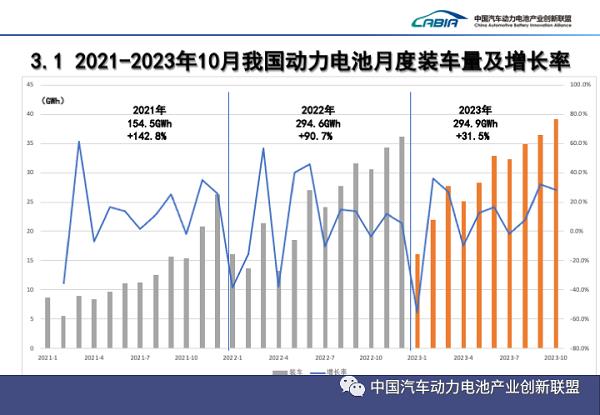
Source: WeChat public platform of China Automotive Power Battery Industry Innovation Alliance
In the technical field, ultra-fast rechargeable batteries make new energy vehicles comparable to fuel vehicles, the meta-universe is changing the in-vehicle experience, large models promote the rapid growth of autonomous driving ability, and even before flying cars take the stage … Many innovative technologies are gathering in the new energy field. According to Tao Qing, spokesperson of the Ministry of Industry and Information Technology, in the first three quarters of this year, China’s new energy automobile industry showed the characteristics of rapid improvement in technical level. The energy density of mass-produced power batteries reached 300 WHr/kg, the average driving range of pure electric passenger cars exceeded 460 kilometers, and the proportion of vehicles with L2 or above self-driving function in passenger cars exceeded 40%.
At the product level, it has become a new energy market of "fairy fights". In 2023, a large number of new China brand members will be added, covering all market segments. Geely Panda mini, Wuling Binguo, BYD Seagull, Baojun Yueye, Jianghuai Yttrium 3, Nezha AYA and Baojun Yunduo in the small car market; Extreme Krypton X, Haval Xiaolong, Geely Yinhe L7, Geely Yinhe L6, Beiqi Polar Fox Koala, Nezha X and Changan Qiyuan A05 in compact market; Deep blue S7, Tucki G6, Tengshi N7, Zhiji LS6, Qichen VX6 and Haoplatinum GT in the medium-sized car market; Zhiji LS7, Weipai Lanshan, Tanks 500 Hi4-T, Gaohe HiPhi Y, Tengshi N8, Feifan F7, Lantu Zhuiguang, Changan Qiyuan A07 in medium and large markets; Chuanqi E9, Hechuang V09 and Weipai Gaoshan DHT-PHEV in MPV market; And look up to U8 and Haoplatinum SSR…… … More than that, there are more generations, changes and new models to join, and China brand new energy vehicles are welcoming the era of a hundred flowers.
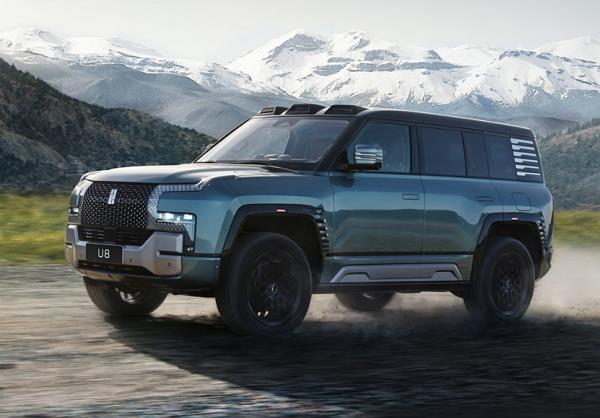
Looking up to U8 Source: Photo courtesy of enterprises
In terms of infrastructure construction, the data released by the National Energy Administration shows that China’s charging infrastructure has increased from hundreds of thousands in the early 13 th Five-Year Plan to 6.928 million by the end of July 2023, an increase of over 60 times; From January to July, the charging capacity of new energy vehicles nationwide reached 44.14 billion kWh, up 99.6% year-on-year, which has exceeded the charging capacity of last year. At the same time, nearly 90% of expressway service areas in China have been equipped with charging facilities. As a result, China has formed a charging infrastructure system with the largest number, the widest service range and the most complete variety in the world.
Li Shaohua, deputy secretary-general of China Automobile Industry Association, confidently said, "After years of development, China’s charging infrastructure industry has established a relatively complete technical standard system, charging facility quality system, charging operation management system, etc., and summarized and formed a series of achievements and experiences."
Opportunities and challenges coexist, and China brands accelerate their upward breakthrough.
With strong policy boost, strong market demand and perfect industrial guarantee, the accelerated development of China’s new energy automobile industry comes naturally. More importantly, new energy vehicles are the best carrier for China’s automobiles to break through and expand outward.
Specifically, in the new energy era, a number of highly competitive automobile brands have emerged in China. In October this year, BYD’s sales exceeded 300,000 vehicles for the first time, which further consolidated the local advantages of China brand. In addition, data released by the Ministry of Industry and Information Technology show that in the first three quarters, the domestic market sales of China brand new energy passenger cars accounted for 80.2%. Among the new brands, LI sold more than 40,000 vehicles in October, and it has got rid of the traditional multinational giants in the luxury SUV market.
Looking around the world, China’s new energy vehicles have also become a beautiful landscape. According to the data of China Automobile Association, from January to October, domestic new energy vehicles exported a total of 995,000 vehicles, a year-on-year increase of 99.1%. More than that, China’s new energy vehicles have also moved to the developed markets in Europe and America. For example, SAIC MG brand sold more than 200,000 vehicles in the European market in the first 10 months, and MG4 EV won the sales champion of European pure electric compact models.
In addition, China’s new energy vehicles are characterized by technological globalization. In July this year, Volkswagen brand and Xpeng Motors reached a technical cooperation framework agreement to jointly develop two Volkswagen brand electric vehicles; Audi also signed a strategic memorandum with SAIC, which will rapidly and efficiently expand the high-end market intelligent networked electric vehicle product portfolio through joint development.
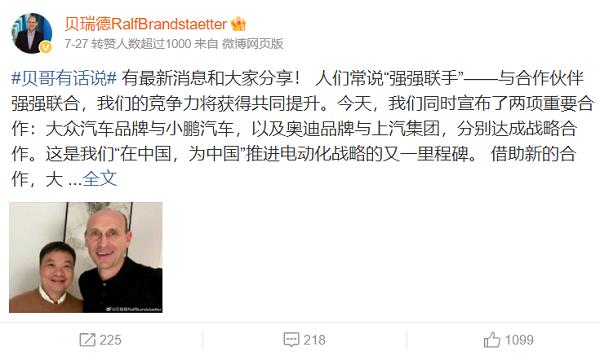
Source: audi ag (China) Chairman and CEO Bered Weibo screenshot
At the same time, however, China’s new energy vehicles are still facing challenges, and their shortcomings need to be overcome urgently.
First of all, there is still unbalanced development in the new energy vehicle market in China. Xin Guobin, vice minister of the Ministry of Industry and Information Technology, said, "From the perspective of urban and rural markets, the rural market has not been fully tapped." The data shows that in 2022, the sales of new energy vehicles in rural areas of China only accounted for 4% of the total sales of vehicles in rural areas, far below the overall level of 25.6% in the industry. According to the Study on Electric Vehicle Travel in Rural Areas of China published by China Electric Vehicle committee of 100, in March this year, the penetration rate of pure electric passenger cars in counties and townships was 16%, and that of hybrid passenger cars was 8%, both of which were far below the level of first-and second-tier cities.
The rural new energy vehicle market is still a blue ocean. According to the relevant research of China Automobile Strategy and Policy Research Center of China Automobile Center, every promotion of a new energy vehicle will drive the value-added of the upstream and downstream industrial chains of automobiles by 2.5 to 3 times. Therefore, supporting new energy vehicles to the countryside will play a vital role in promoting new energy vehicles in China and even the overall economic development.
Furthermore, China’s new energy vehicles still have shortcomings in some key areas. Wan Gang, chairman of China Association for Science and Technology, once bluntly said that there are still some problems in the development of new energy automobile industry, such as high price of basic resources, poor supply chain and some technical constraints. Fu Bingfeng, executive vice president and secretary general of China Automobile Industry Association, also believes that the shortcomings of China’s new energy automobile industry in the fields of chips, basic software and key materials need continuous efforts to make up. (China Economic Net reporter Guo Yue)
关于作者